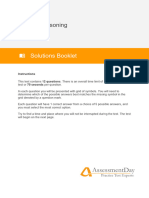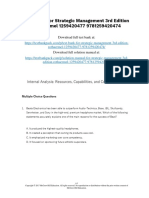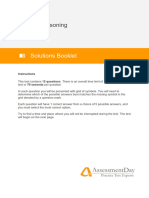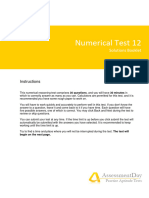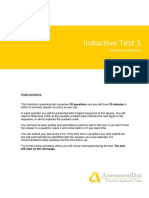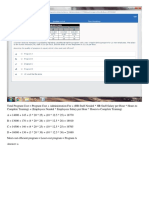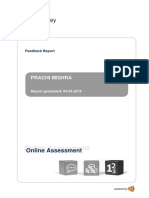SJT3 Answers
SJT3 Answers
Uploaded by
td342003Copyright:
Available Formats
SJT3 Answers
SJT3 Answers
Uploaded by
td342003Original Description:
Original Title
Copyright
Available Formats
Share this document
Did you find this document useful?
Is this content inappropriate?
Copyright:
Available Formats
SJT3 Answers
SJT3 Answers
Uploaded by
td342003Copyright:
Available Formats
Practice Situational Judgement Test 3
Answers Booklet
This is an example situational judgement test (SJT) which will allow you to become familiar
with this format of test. SJTs are commonly used by employers as part of their selection
process.
If you have been invited to sit a SJT this simply means the employer is trying to establish
how you would potentially behave in different situations. The fictional situations you will face
are usually designed by the employer to simulate the kind of decision-making you might be
faced with during your employment with them. Employers will have a set of responses which
reflects how their ideal candidate would respond. Your responses can be compared against
their model responses to help the employer decide if you are a good fit within their
organisation. But remember this test is just one contributing factor to a rounded selection
process; employers will never use the results from one test in isolation, so don't worry if you
feel you haven't done well.
There is no time limit to this test however your first answers are usually the most accurate,
so try not to spend too long thinking about each one. There are four different scenarios to
this test and each scenario contains four questions.
Scenario 1: Most and Least Likely to Perform
Scenario 2: Ranked Response
Scenario 3: Most and Least Effective
Scenario 4: Rated Responses
The questions begin on the next page
Practice Situational Judgement Test
1. Most and Least Likely to Perform
In this test you will be asked to imagine yourself in a number of different scenarios and roles.
You will be presented with situations and asked to select the response you believe you
would be ‘most’ and ‘least’ likely to make to these situations from a range of options. It is
recommended you read all the possible responses before deciding how to respond.
As this test is designed to help you practice your approach to Situational Judgement Tests,
commentary is provided giving information on which answers are considered to be most
effective, least effective and which answers are somewhere in between. Of course, there is
always a certain level of judgement involved with regard to how effective each response is
likely to be.
The commentary provided is based on a considered understanding of global, generic
competencies for each level; in other words, what ‘most’ organisations and employers would
expect from their employees.
The ideal response will vary from organisation to organisation and this should be borne in
mind when completing an SJT in a live, recruitment context. Being aware of the
organisational competencies, culture and style of your potential employer is very important
when deciding your answers to a Situational Judgement Test, in addition to drawing on your
own experience, skills and approach.
SCENARIO 1
You are a manager at the Saldringham branch of a national DIY superstore chain. The chain
is called Distinctly DIY and you are one of 4 duty managers who work daily shifts at the
Saldringham store and who report to the Store Manager.
The store is divided into two main areas; 1) interior DIY, plumbing and decorating and 2)
exterior DIY, gardening, garden buildings and furniture. There are usually 2 duty managers
working on any one shift and each duty manager will be responsible for one of the two
areas. The shifts are 7.30am to 3.30pm and 12.30pm to 8.30pm. The store is open 8am to
8pm every day apart from Sundays when it is open from 10am to 4pm. The duty manager is
responsible for managing staff, overseeing stock control and dealing with any difficult
customer complaints or queries. There are 8 full-time shift team leaders who report to the
duty managers and act as shopfloor supervisors whilst also serving customers.
When a fellow duty manager is on annual or sick leave then the other duty manager and the
Store Manager share responsibility for managing their half of the store.
There are 84 staff employed at your branch in total, on both a part-time and full-time basis.
For personal use only. Unauthorised copying or Page 2
distribution in printed, electronic, or any other
form in whole or in part, is prohibited without
AssessmentDay
Document last updated 09-04-2013 www.assessmentday.co.uk
prior written permission from AssessmentDay.
Practice Situational Judgement Test
Situation 1:
You have arrived for work at 7.30am on a Friday to find that, out of the 19 staff due in for the
early shift on the ‘exterior DIY and gardening’ area, five have not turned up. You are
responsible for this area today.
All five of the absent staff have caught a severe flu-like virus which is affecting a high
number of people in Saldringham at the moment. Today is due to be very busy as you are
expecting a large delivery of garden sheds and Fridays are often quite busy in the shop as
people pop in to stock up on DIY and gardening supplies for the weekend. The gardening
team leader and the exterior DIY team leader inform you that to unload the delivery and deal
with the store customers effectively this morning they need a minimum team of 17 people.
Review the following responses A to D and indicate which one you believe to be the
response to the situation you would be ‘most likely to make’ and the response to the
situation which you would be ‘least likely to make’.
Competency being measured: Managing Tasks & Objectives
Responses:
A) Delegate the problem to the team leaders to sort out.
(Not a particularly appropriate response as the problem is one that will have a big
impact on the store’s performance today, it should be your top priority.)
B) Tell the team leaders to engage three agency staff today to deal with the delivery and
other outstanding tasks.
(This is a reasonable response as the agency staff can work across the two shifts today
and to deal with any backlog of work and the cost of employing them is probably justified
due to the busy schedule today. However the agency staff will require briefing if they
haven’t worked at Distinctly DIY before.)
C) Call a staff meeting and tell all staff to make sure they get an inoculation against the
virus.
(This is the least effective response as, although this may be relevant to preventing
future absences, it doesn’t deal with the immediate problem.)
D) Call all members of the part-time Saturday staff team and ask whether they can
come in today for a few hours.
(This is the most effective response as the staff will not require any training or briefing
to be able to complete the tasks and the overtime incurred is justified due to the busy
schedule).
For personal use only. Unauthorised copying or Page 3
distribution in printed, electronic, or any other
form in whole or in part, is prohibited without
AssessmentDay
Document last updated 09-04-2013 www.assessmentday.co.uk
prior written permission from AssessmentDay.
Practice Situational Judgement Test
Situation 2:
Over the past few weeks you have noticed a drop in performance from one of the team
leaders, Brenda Backley. She is usually a positive, efficient and communicative team leader.
However, recently she has been late on a number of occasions and her demeanour has
been lacking in energy. She has failed to lead her team to meet their sales targets on two
consecutive weeks which is very unusual for Brenda. Brenda is a shift team leader for the
bathroom, kitchen and plumbing team.
Brenda mentioned to you a month or so ago that she and her husband were undertaking a
trial separation but since then she hasn’t talked to you about it. This may partly be because
she has been working on different shifts from you and you have frequently been rostered
away from her area. Today you are duty manager for the ‘interior DIY, plumbing and
decorating’ area and Brenda is working the same shift as you.
Review the following responses A to D and indicate which one you believe to be the
response to the situation you would be ‘most likely to make’ and the response to the
situation which you would be ‘least likely to make’.
Competency being measured: Managing People
Responses:
A) Ask Brenda how she is doing and whether she’s still enjoying her job at Distinctly
DIY.
(Not a particularly appropriate response as you are not making it clear to Brenda why
you are asking her this question and she may not realise that you are referring to a
performance issue.)
B) Have a chat with Brenda in private, bring up her decline in sales figures and mention
her change in behaviour. Ask her what her view is on this problem and ask how you
can help.
(This is the most effective response as you will probably not be able to do much about
the underlying cause of Brenda’s problems, if it does turn out to be personal. But you can
support her in the workplace at this difficult time e.g. by delegating some of his tasks to
staff members or by helping her ask for compassionate leave, if necessary).
C) Talk to Brenda and tell her that she shouldn’t allow her personal problems to
influence her behaviour at work. Tell her that you would like to see an improvement
in her sales figures very soon.
(This is the least effective response as you are doing nothing to support Brenda and it
is unlikely that, without support, she will be able to tackle any issues she has whether
they be work problems or personal ones.)
For personal use only. Unauthorised copying or Page 4
distribution in printed, electronic, or any other
form in whole or in part, is prohibited without
AssessmentDay
Document last updated 09-04-2013 www.assessmentday.co.uk
prior written permission from AssessmentDay.
Practice Situational Judgement Test
D) Ask one of Brenda’s close friends at work to have a word with her and find out what
is going on. Tell the friend that she should encourage Brenda to ask for help if she
needs it.
(A reasonable response as Brenda may find it easier to talk to a friend. However she
may also have liked to have been directly offered support from the management team
(i.e. you in this instance) and perhaps it would be better for you to talk to her directly as
well. Also, even though you haven’t asked the friend to report back to you, Brenda may
be annoyed if she hears that you asked the friend to intervene; she may feel that she is
being spied upon.)
For personal use only. Unauthorised copying or Page 5
distribution in printed, electronic, or any other
form in whole or in part, is prohibited without
AssessmentDay
Document last updated 09-04-2013 www.assessmentday.co.uk
prior written permission from AssessmentDay.
Practice Situational Judgement Test
Situation 3:
It is 8.45am on a Monday and you have returned to the managers’ office from your morning
‘floorwalk’ to find an urgent email on your laptop. The email is addressed to the Store
Manager and Duty Managers of the Saldringham store. It is from Head Office saying that
Brian Bentley, the Director of Retail & Merchandising, is going to drop in to the Saldringham
branch today for a brief visit on his way to a meeting in London. He will be arriving at about
10.30am and is hoping to have a chat with the management team and some of the shopfloor
staff and team leaders just to say hi and get a feel for the store. He would also like to see
the last month’s sales figures and details of any ongoing stock or merchandising issues. You
have never met Brian before as he is a recent hire onto the Distinctly DIY Board of Directors.
Review the following responses A to D and indicate which one you believe to be the
response to the situation you would be ‘most likely to make’ and the response to the
situation which you would be ‘least likely to make’.
Competency being measured: Relationship & Reputation Building
Responses:
A) Let Brian see your area ‘warts and all’ and do little more than your usual morning
routine until he arrives. After all he can’t make useful suggestions or an assessment
of the operation if you present a false impression.
(A reasonable response although you could probably to do a little more to find out
about Brian as a person and his expectations of you and your team. This would help you
to tailor what you say to him and how you communicate any merchandising issues.)
B) Inform your area team that Brian Bentley is visiting this morning and tell them who he
is by researching Brian’s background on the Distinctly DIY intranet site. Check with
the other managers that someone is dealing with the request for the sales figures.
(This is the most effective response as you are not creating an emotional response in
your team toward Brian and you are treating the visit in a calm and matter-of-fact way.
Also, by finding out a little about him, you can tailor your communication with him to
include his particular areas of interest. For example, store layout, special offer promotion,
stock control efficiency etc).
C) Walk the floor again to inform the shift staff and team leaders on your area this
morning that they must be on their best behaviour for Brian as he is a very important
person and there might be implications for the store if he is unimpressed.
(This is the least effective response as you are likely to engender a sense of panic in
the team; after all you are implying that they don’t normally work to their best level of
performance. Also, by taking this view, you and your team may begin to see Brian as
someone to be feared rather than someone to engage with and with whom to build a
productive working relationship.)
D) Hunker down with some paperwork in your office and leave the other managers to
meet and greet Brian; he doesn’t need the whole store to turn out to speak to him.
(Not a particularly appropriate response as you are not taking any responsibility for
building a good relationship with Brian, also you haven’t let the staff in your area know
about Brian’s visit and they may be caught ‘offguard’.)
For personal use only. Unauthorised copying or Page 6
distribution in printed, electronic, or any other
form in whole or in part, is prohibited without
AssessmentDay
Document last updated 09-04-2013 www.assessmentday.co.uk
prior written permission from AssessmentDay.
Practice Situational Judgement Test
Situation 4:
Distinctly DIY have decided to run a nationwide promotion on their own-brand fitted
bathrooms. There is to be a national TV and press advertising campaign starting next week
to promote the Distinctly bespoke bathroom fitting service. Customers are being offered a
chance to benefit from a free design and fitting service for their bathroom if they purchase a
Distinctly own-brand bathroom suite during the next 8 weeks.
The Saldringham store expects that this will be a very popular promotional offer as the
design and fitting can add a reasonable amount onto the overall cost of a new bathroom
after the hardware has been purchased. You have been charged with managing the
presentation of the promotion in store. You need to set up a display bathroom using the
Distinctly own-brand products and place posters and information stands around the display
containing information about the promotion. However, there is no available space in the
bathroom section at the moment for such a large display.
Review the following responses A to D and indicate which one you believe to be the
response to the situation you would be ‘most likely to make’ and the response to the
situation which you would be ‘least likely to make’.
Competency being measured: Analytical Thinking & Decision-making
Responses:
A) Temporarily dismantle the sample bathroom suite of the leading bathroom hardware
brand to allow space for the promotional display.
(Not a particularly appropriate response as you may lose sales due to the lack of
information on the leading brand and you may negatively affect the relationship with this
supplier as well.).
B) Set up the display in the checkout area at the front of the store where there is space
and it will be spotted by a high number of customers.
(A reasonable response as this will avoid having to rearrange the bathroom section;
however it may also be a good idea to put a smaller display with information on the offer
in the bathroom section so that people who are looking seriously for a new bathroom
suite will be aware of the offer.)
C) Inform your Store Manager that there is no space available at present for the in-store
display and that you will put promotional leaflets at the checkout instead.
(This is the least effective response as you are failing to meet the brief that you have
been given and the effectiveness of the promotion will be reduced as fewer customers
will be made aware of what is on offer.)
D) Work with the bathroom, kitchen and plumbing shift team leaders to decide how the
bathroom section can be rearranged to accommodate the temporary display. If
necessary, suggest splitting the promotional information between the front of the
store and the bathroom section.
(This is the most effective response as you are ensuring a good coverage of the
relevant places in the store where target customers might be. Also you are involving the
people who know the most about the layout of the bathroom section and what could
possibly be sacrificed temporarily to make way for the promotional display).
For personal use only. Unauthorised copying or Page 7
distribution in printed, electronic, or any other
form in whole or in part, is prohibited without
AssessmentDay
Document last updated 09-04-2013 www.assessmentday.co.uk
prior written permission from AssessmentDay.
Practice Situational Judgement Test
2. Ranked Responses
In this test you will be asked to imagine yourself in a number of different scenarios and roles.
You will be presented with situations and asked to rank each of the responses to these
situations from 1 to 4 with regard to your opinion of their effectiveness.
As this test is designed to help you practice your approach to Situational Judgement Tests,
commentary is provided giving information on which answers are considered to be the most
effective response, the second, the third and the least effective response. Of course, there is
always a level of judgement involved with regard to how effective each response is likely to
be, and some people may have different opinions.
The commentary provided is based on a considered understanding of global, generic
competencies for each level of role; what ‘most’ organisations and employers would expect
from their employees. The ideal response may vary from organisation to organisation and
this should be borne in mind when sitting an SJT in a live, recruitment context. Being aware
of the organisational competencies, culture and style, as well as drawing on your own
experience and skills, is very important when deciding your answers to a Situational
Judgement Test.
SCENARIO 2
You are currently employed as an Operational Manager for UK Airports plc. You are based
at Saldringham Airport which is a small but growing airport serving primarily domestic
destinations but which has recently added a selection of international routes, mainly to
popular holiday destinations. The airports serves approximately 2 million passengers per
year.
There are 4 Operational Managers working at Saldringham Airport, you all report in to the
Director of Airport Services, Sheela Bharvi. You work on a rotational basis as Duty
Managers. The airport operates from 5am to 11pm daily and therefore two Duty Managers
are rostered on each day to cover the full opening hours. The first shift is 5am to 2pm and
the second is 2pm to 11pm. You work on a ‘4 days on 3 days off’ basis each week;
therefore, there is usually one day per week when all four managers are working. This
enables communication and planning to take place between the team and for issues to be
resolved which need general agreement. Sheela usually makes sure that she is available on
the day when all four managers are working at once so that a proper team meeting can be
held.
Your responsibilities as Duty Manager are to ensure the smooth running of the airport,
including passenger services, commercial operations, security and airside services. Your
primary aim is to allow flights to depart on time, safely and with a “fantastic passenger
experience”. You also have commercial targets to encourage passenger spending in your
retail tenants’ shops and premises throughout the airport.
For personal use only. Unauthorised copying or Page 8
distribution in printed, electronic, or any other
form in whole or in part, is prohibited without
AssessmentDay
Document last updated 09-04-2013 www.assessmentday.co.uk
prior written permission from AssessmentDay.
Practice Situational Judgement Test
Situation 1:
You have just come out of the operational management team meeting for this week. It is
Sunday 4th April. You are on shift this afternoon from 2pm to 11pm. In the meeting, Sheela
Bharvi informed the team that the UK Airports plc senior management felt that Saldringham
Airport was underperforming in its non-food retail sales, compared to other similar size
airports in the group. They want to see Saldringham’s figures for this type of sales increase
in the first quarter of this year, by 25%. These sales include electrical goods, toiletries and
pharmaceuticals, luggage, clothes and gift items. Sheela informed you all that the senior
managers had no specific directions as to how you should achieve this target; they were
happy to leave this to you to decide within your team.
The two morning shift Duty Managers, Elizabeth Swift and Harvey MacDonald are due to
leave work now, as the meeting with Sheela is over. You are sharing this afternoon’s shift
with Sondra Thuyssen.
Review the following responses A to D and indicate whether you believe the response to be
1 – The most effective response, 2 – The second most effective response, 3 – The third
most effective response or 4 – The least effective response . You may assign each rating
only once.
Competency being measured: Managing Tasks & Objectives
Responses:
A) Suggest to Sondra that you and she go to lunch now and begin the process of
planning how to achieve these targets.
(The second most effective response. You are tackling the issue with a sense of
urgency, which is required as the target is stretching and you have little time to achieve
it. However, you risk having to spend more time in the near future, explaining your ideas
to your two colleagues and convincing them of your suggestions. If you involved them in
the planning and ideas-generation right now, then you could all be fully committed to the
effort from the beginning.)
B) Suggest that when you have your next team meeting, in a week’s time, you spend
some time generating ideas as to how to achieve these targets.
(The least effective response. This is putting in an unnecessary delay into the process
when you could all begin (either separately or together) to start contemplating ‘what to
do’ earlier than next week.)
C) Ask Harvey & Elizabeth to stay on for another half an hour or so now, for a working
lunch, to generate some ideas together as to how you can achieve this target.
(The most effective response. This target is a challenging one and you are already
starting the first financial quarter. Therefore you don’t have much time to start doing
things that might have an effect on your results (e.g. special offers, more advertising
around the airport etc). If the four of you can start the ball rolling today then that should
give you a headstart to tackling this challenge; and it should give you a plan on which
you can all agree as well.
For personal use only. Unauthorised copying or Page 9
distribution in printed, electronic, or any other
form in whole or in part, is prohibited without
AssessmentDay
Document last updated 09-04-2013 www.assessmentday.co.uk
prior written permission from AssessmentDay.
Practice Situational Judgement Test
D) Offer to bring a list of suggestions for pursuing this target to the meeting next week
as a basis for planning between the four of you.
(The third most effective response. This is a useful ‘fallback’ position; however it would
be even better if all four of you could do this activity if you can’t get together as a group
before next week. If all four of you bring plans and ideas to the meeting then you will
have a greater chance of producing a strategy which will be robust, successful and that
is one on which you can all agree.)
For personal use only. Unauthorised copying or Page 10
distribution in printed, electronic, or any other
form in whole or in part, is prohibited without
AssessmentDay
Document last updated 09-04-2013 www.assessmentday.co.uk
prior written permission from AssessmentDay.
Practice Situational Judgement Test
Situation 2:
You have just been having an informal catch-up with the Airside Security Team Leader,
Simon Bryant. He informed you during your conversation that one of his team, Graham
Cooper, a Senior Security Officer, has taken a rather high number of sick days over the last
few months. In fact, Graham’s sickness absence for the last three months is much higher (10
days) than it was a year ago for the same period (2 days).
Simon said to you that the sick days have mostly been one day here or there, with no
significant long run of absence. Simon has followed the correct procedures by having a chat
with Graham upon his return from each absence to check that everything is OK; however,
Simon hasn’t been able to work out if there is a serious medical issue or if something else is
going on for Graham. Simon has never had to deal with a case like this before as he is new
to the role of Team Leader. UK Airports plc have a formal interview procedure which
a more senior member of staff must conduct with an employee who has been absent for
more than 2 days in a month. Clearly, this is now the case for Graham; however, Simon is a
little anxious about running this process, due to his relative inexperience.
Review the following responses A to D and indicate whether you believe the response to be
1 – The most effective response, 2 – The second most effective response, 3 – The third
most effective response or 4 – The least effective response . You may assign each rating
only once.
Competency being measured: Managing People
Responses:
A) Offer to sit in with Simon when he conducts the meeting and give him feedback
afterwards.
(The second most effective response. This will be helpful to Simon’s development and
skills in the long run; however he might benefit from some input beforehand as well in
order to build his confidence and understanding of the process.)
B) Suggest that you conduct the meeting and Simon can take notes.
(The least effective response. This could have the effect of undermining Simon’s
position and confidence and not giving him the opportunity to gain the experience he
needs in order to tackle this kind of issue with poise in the future.)
C) Book in some time very soon to talk through the process of running the sickness
absence interview with Simon and ensure he is confident with the task.
(The most effective response. Simon has to be the one who conducts the meeting but
he needs support to boost his confidence. Giving some quality time to him to talk through
the process should help him be prepared and less anxious about the event.).
D) Give Simon details of the link on the UK Airports plc internal website which gives full
information about the sickness absence management procedure.
(The third most effective response. Simon has probably already accessed this but even
if he hasn’t, it may do little to allay his fears as he won’t have a chance to ask questions
or be assured that he is going to approach things in the correct manner.)
For personal use only. Unauthorised copying or Page 11
distribution in printed, electronic, or any other
form in whole or in part, is prohibited without
AssessmentDay
Document last updated 09-04-2013 www.assessmentday.co.uk
prior written permission from AssessmentDay.
Practice Situational Judgement Test
Situation 3:
The Airside Security Team is responsible for screening passengers and their luggage for any
harmful devices. This involves a number of procedures, including scans and sometimes a
manual search of the passenger by a Security Officer. This afternoon you have been called
to the security screening area to deal with a disgruntled passenger.
The passenger, whose name is Mrs Selina Hatterson, is objecting to being searched by a
security officer. Mrs Hatterson passed under the walkthrough metal detector. The detector
made an alert noise and the security team requested that Mrs Hatterson step to one side
and submit to a manual scan and over-clothes search, sometimes called a ‘pat down’; she
refused despite the security officer being female. It was suggested that the ‘pat down’ to be
conducted in private; she still refused. She then asked to speak to the person in charge.
Simon Bryant was called and he spoke to her, but she was dissatisfied and asked to speak
to the “real boss”. That is why you have been asked to attend. Mrs Hatterson says that she
is “a seventy-five year old retired solicitor” and says she is not a security threat and is
uncomfortable with being searched.
Mrs Hatterson has now been in the security area for half-an-hour and her plane is due to
take off in 20 minutes. If she doesn’t comply with security she will not be allowed to board
her plane.
Review the following responses A to D and indicate whether you believe the response to be
1 – The most effective response, 2 – The second most effective response, 3 – The third
most effective response or 4 – The least effective response . You may assign each rating
only once.
Competency being measured: Relationship & Reputation Building
Responses:
A) Say to Mrs Hatterson that you can understand how she feels but that there is nothing
you can do about UK law unfortunately.
(The second most effective response. You are being empathic and non-judgemental,
however you could perhaps be even clearer with regard to the law and regulations as
they stand in reference to Mrs Hatterson.)
B) Escort Mrs Hatterson out of the airport terminal with her luggage and tell her she will
not be flying today as she hasn’t complied with security procedures.
(The least effective response. You are not giving her a final chance to make a choice
based on a full understanding of the consequences.)
C) Sit down with Mrs Hatterson and explain that she has a choice, but that if she
chooses not to take part in the security process then she will not be allowed to fly.
(The most effective response. You are taking time to speak in a calm, unhurried way
(sitting down with her) but being very clear about the consequences for her of any
choices that she makes. Hopefully making her realise that it is her choice will help her.).
D) Tell Mrs Hatterson that she has only 20 minutes left to get on her flight.
(The third most effective response. This is true, however you are not making clear to
her what she has to do in order to pass through security or that if she fails to comply she
will not be able to fly.)
For personal use only. Unauthorised copying or Page 12
distribution in printed, electronic, or any other
form in whole or in part, is prohibited without
AssessmentDay
Document last updated 09-04-2013 www.assessmentday.co.uk
prior written permission from AssessmentDay.
Practice Situational Judgement Test
Situation 4:
You have received an email from Sheela Bharvi stating that Chips Airline, a small but
growing ‘no frills’ provider, has made a request which needs to be considered and
responded to in the next week. She wants to know your views on Chips’ requirements and
has asked that you email her back by close-of-play today.
Chips Airline currently runs three return flights a day from Saldringham Airport, one each to
three major UK cities. Because Chips are cheap, punctual and have a fun image, their
popularity is growing. Chips’ CEO Georgiou O’Donnell is known for the innovative and
groundbreaking changes that he has made to the airline industry. He now wants to introduce
standing room only flights on the three Chips routes to and from Saldringham. Passengers
would stand up throughout the entire flight and be made safe through a secure harness for
take-off and landing. This would enable Chips to double the number of passengers per flight
and to charge its passengers even less for their tickets.
The implications for Saldringham Airport are that passenger numbers could increase but that
there would be no increased revenue for the airport as airlines are charged per flight for the
services that the airport provides.
Review the following responses A to D and indicate whether you believe the response to be
1 – The most effective response, 2 – The second most effective response, 3 – The third
most effective response or 4 – The least effective response . You may assign each rating
only once.
Competency being measured: Analytical Thinking & Decision-making
Responses:
A) Recommend that Sheela refuses the request.
(The least effective response. This could result in Saldringham losing Chips’ business
altogether or at the very least bad publicity for Saldringham as Chips is a popular
company. Also, it is initially only three flights out and three flights in per day which will be
affected. The impact on total passenger numbers per day at the airport will not be
proportionately very large.)
B) Recommend that Sheela accept the request and UK Airports plc renegotiate their
contract with Chips Airline to enable an increase in service charges.
(The second most effective response. This is a reasonable suggestion, however this
depends on when the contract is due to be re-negotiated and whether Chips have other
options in terms of your rival airports with whom they could also make a deal.)
C) Recommend that Sheela accept the request and that the airport look at ways to
maximise commercial revenue from those extra passengers.
(The most effective response. This option is viable whatever the contractual
arrangements with Chips; you are keeping their business and turning the situation into a
‘win-win’ for Chips and the airport. You would, of course, need to plan carefully to
manage the increase in operational workload dealing with the increase in passenger
numbers.).
For personal use only. Unauthorised copying or Page 13
distribution in printed, electronic, or any other
form in whole or in part, is prohibited without
AssessmentDay
Document last updated 09-04-2013 www.assessmentday.co.uk
prior written permission from AssessmentDay.
Practice Situational Judgement Test
D) Ask your fellow Duty Managers for their views before you give your input to Sheela.
(The third most effective response. There is some benefit to gaining the views and
input of others as they may have thought of issues that you have overlooked. However, it
is probably best that Sheela collates all your input rather than you doing it. After all she
has asked for your individual views and not a collective response so she must be
intending to review all the responses to help her make a decision; therefore the more
differing viewpoints that she can gather, the more useful this will be for her.)
For personal use only. Unauthorised copying or Page 14
distribution in printed, electronic, or any other
form in whole or in part, is prohibited without
AssessmentDay
Document last updated 09-04-2013 www.assessmentday.co.uk
prior written permission from AssessmentDay.
Practice Situational Judgement Test
3. Most and Least Effective Responses
In this test you will be asked to imagine yourself in a number of different scenarios and roles.
You will be presented with situations and asked to select the ‘most’ and the ‘least’ effective
responses to these situations from a range of options.
As this test is designed to help you practice your approach to Situational Judgement Tests,
commentary is provided giving information on which answers are considered to be most
effective, least effective and which answers are somewhere in between. Of course, there is
always a certain level of judgement involved with regard to how effective each response is
likely to be, which in practice will be applied by the company for whom the test is being
conducted. You will see that with situational judgement tests you might find yourself thinking
"it depends"; this is almost inevitable but the consensus is that over the range of questions,
your responses will average out and your true behaviour characteristics will be revealed.
The commentary provided is based on a considered understanding of global, generic
competencies for each level; in other words, what ‘most’ organisations and employers would
expect from their employees.
The ideal response will vary from organisation to organisation and this should be borne in
mind when completing a situational judgement test in a live, recruitment context. Being
aware of the organisational competencies, culture and style of your potential employer is
very important when deciding your answers to a Situational Judgement Test, in addition to
drawing on your own experience, skills and approach. It would help if you have an
understanding of the culture and attitudes of the company you are applying to. Often, the
company describe the qualities they are looking for in the job advertisement, or on their
website.
SCENARIO 3
You are the manager of a distribution depot for SuperSwift Deliveries. SuperSwift provide
clients with a timely courier and distribution service for dry goods of any volume or weight.
The company has a chain of depots throughout the UK and a fleet of large volume lorries for
moving goods large distances around the country. Each depot also has a number of smaller
collection and delivery vans. These vans are used for local distribution of goods once they
have been sorted and prioritised for delivery at the depot. They are also used to collect
goods from customers to sort for outbound distribution to other parts of the country.
You manage 52 depot processing staff who work in 3 shifts (each shift has a Shift Manager)
to sort the goods that arrive from other depots and from local customers. You also have a
team of 36 collection and delivery drivers who report to a Delivery Team Manager who
reports into you. The lorry drivers, who bring goods into the depot from elsewhere in the
country and who collect goods for national distribution, are managed centrally from
SuperSwift HQ and are not your direct managerial responsibility.
The depot is open 24 hours a day, 364 days a year.
For personal use only. Unauthorised copying or Page 15
distribution in printed, electronic, or any other
form in whole or in part, is prohibited without
AssessmentDay
Document last updated 09-04-2013 www.assessmentday.co.uk
prior written permission from AssessmentDay.
Practice Situational Judgement Test
Situation 1:
You have arrived for work at 7.30am on a Tuesday and your morning shift manager tells you
that, out of the 16 staff due in for the 6am - 2pm shift, six have not turned up. The absences
are due to a mixture of illness and personal issues. Tuesday mornings are usually very busy
and today is no exception. There are already three lorries waiting to be dealt with in the
loading and unloading bays. Your shift manager informs you that to clear the workload
effectively this morning he needs a minimum team of 13 people.
Review the following responses A to D and indicate which you believe to be the ‘most
effective’ response to the situation and which the ‘least effective’.
Competency being measured: Managing Tasks & Objectives
Responses:
A) Delegate the problem to the Shift Manager to sort out; it’s his team after all.
(Not a particularly appropriate response as the problem is one that will have a big
impact on your depot’s performance and the Shift Manager may need support with the
decision)
B) Tell the Shift Manager to employ three agency staff for the remainder of the shift.
(A reasonable response but the agency staff may take a few hours to arrive and the
backlog of work will have become greater in the meantime; there is also a cost
implication)
C) Phone the six staff members who haven’t turned up and urge them to come into
work, as it is a dire emergency.
(This is the least effective response as you could be accused of bullying and
harassment for contacting staff that have legitimate reasons for absence and it will
impact on long-term morale)
D) Reassign some of the morning shift delivery drivers, none of whom are absent today,
to help with the depot processing work until the backlog is cleared.
(This is the most effective response as there will be very little delay in implementing
this and the delivery staff are dependent on the goods being processed at the depot
anyway before they can leave on their rounds. This response would need to be
supported with clear briefing and planning from you and the Shift Manager).
For personal use only. Unauthorised copying or Page 16
distribution in printed, electronic, or any other
form in whole or in part, is prohibited without
AssessmentDay
Document last updated 09-04-2013 www.assessmentday.co.uk
prior written permission from AssessmentDay.
Practice Situational Judgement Test
Situation 2:
Over the past few weeks you have noticed a drop in performance from your Delivery Team
Manager, Stanley Hillman. He is usually an upbeat, punctual, efficient and well-liked
manager. However, recently he has been late on a number of occasions, his demeanour has
been lacking in energy, even sad at times, and this is affecting the morale of the delivery
drivers. Some of the drivers have come to you to say that they are worried about Stanley
and that they think he may be having personal problems. He has spoken to you about his
twenty-year old daughter before who had been involved with drugs and had ‘gone off the
rails’, although he hasn’t talked about her to you for a few months.
Review the following responses A to D and indicate which you believe to be the ‘most
effective’ response to the situation and which the ‘least effective’.
Competency being measured: Managing People
Responses:
A) Do nothing for the moment. If Stanley’s daughter is causing him emotional upset then
there’s not a lot you can do about it and he’s quite resilient so he’ll probably pull
through this one himself and be back to his usual self soon.
(Not a particularly appropriate response as Stanley’s behaviour is already having an
impact on staff morale and if he is experiencing emotional distress then this might affect
his work performance in other ways too.)
B) Check Stanley’s paperwork for the past month to make sure his work is still to a high
standard. Set aside a convenient hour for a one-to-one chat with Stanley. Talk him
through the changes in his behaviour (and performance, if appropriate) that you have
noticed and suggest that his staff may have noticed these things as well. Ask if he is
aware of what might have caused his behaviour to change. Ask if there is anything
that you can do to support him at work. Implement the solutions that Stanley and you
agree.
(This is the most effective response as you will probably not be able to do much about
the underlying cause of Stanley’s problems, if they do turn out to be personal. But you
can support him in the workplace at this difficult time e.g. by delegating some of his tasks
to team members or by giving him some compassionate leave, if necessary).
C) Call Stanley into your office and tell him that he shouldn’t allow his personal problems
to influence his behaviour at work. Tell him that he has a responsibility for the morale
of his staff and that you would like to see an improvement in his behaviour by the end
of the week.
(This is the least effective response as you may be liable to claims of bullying and
harassment but also you are doing nothing to support Stanley and it is unlikely that,
without support, he will be able to, very easily, get back to his ‘old self’.)
For personal use only. Unauthorised copying or Page 17
distribution in printed, electronic, or any other
form in whole or in part, is prohibited without
AssessmentDay
Document last updated 09-04-2013 www.assessmentday.co.uk
prior written permission from AssessmentDay.
Practice Situational Judgement Test
D) Check on Stanley’s work record for the past month. Look at his paperwork returns
and completed rosters to get some clues as to whether his emotional state is having
an effect on his work performance. If his work performance isn’t suffering, then take
him for a drink after work and tell him that he can always talk to you if he needs a
‘listening ear’.
(A reasonable response but you are making assumptions about the cause of Stanley’s
behaviour and, although you are offering him a form of emotional support, it may be wise
to offer him some support with work duties to prevent any possible performance issues
later on. You are also not being honest with him about the impact that his demeanour is
having on staff morale.)
For personal use only. Unauthorised copying or Page 18
distribution in printed, electronic, or any other
form in whole or in part, is prohibited without
AssessmentDay
Document last updated 09-04-2013 www.assessmentday.co.uk
prior written permission from AssessmentDay.
Practice Situational Judgement Test
Situation 3:
It is 8am on a Monday and you have arrived at work to find an urgent note from your
assistant on your desk. She says that Ms Beverly Thornton, SuperSwift Director of
Operations has called to say she is on her way for a ‘drop in’ visit this morning. She will be
arriving at about 10.30am and hoping to have a chat with you and some of your depot staff
just to see how everything is going. She would also like to see your last quarter’s service
quality figures and details of any ongoing customer issues. You have never met Beverly
before as she is a recent addition onto the SuperSwift Board of Directors.
Review the following responses A to D and indicate which you believe to be the ‘most
effective’ response to the situation and which the ‘least effective’.
Competency being measured: Relationship & Reputation Building
Responses:
A) Let Beverly ‘take you as she finds you’ and do little more than your usual morning
routine until she arrives. Let the team know she will be visiting. Ask your assistant to
sort out the figures and information that Beverly has asked to see.
(A reasonable response although you could probably to do a little more to find out
about Beverly as a person and her expectations of you and your team. This would help
you to tailor your presentation of the depot accordingly.)
B) Inform the team that Beverly Thornton is visiting this morning and tell them who she
is. Ask your assistant to sort out the figures and information that Beverly has asked to
see. Review the SuperSwift company report to remind yourself of Beverly’s
background and career and to make a guess at her likely areas of interest.
(This is the most effective response as you are not creating an emotional response in
your team toward Beverly and you are treating the visit in a calm and matter-of-fact way.
Also, by finding out a little about her and her career-to-date, you can tailor your
communication with her to include her areas of interest. For example, quality measures,
process, staff empowerment etc).
C) Call an emergency meeting of the depot processing shift staff and the drivers who
are not out on the road. State that they must put on a ‘good display’ for Beverly as
she is a very senior manager and there might be implications for the depot if she
takes a poor view.
(This is the least effective response as you are likely to undermine the morale of the
team; after all you are implying that they don’t normally work to their best level of
performance. Also, by taking this view, you and your team may begin to see Beverly as
someone to be feared rather than someone to engage with and with whom to build a
productive working relationship.)
D) Do nothing apart from your usual work; you are confident that Beverly will be
impressed with what she finds in your depot.
(Not a particularly appropriate response as your team should be warned about the
visit and also it is discourteous not to have the information that she requested available
to view when she arrives.)
For personal use only. Unauthorised copying or Page 19
distribution in printed, electronic, or any other
form in whole or in part, is prohibited without
AssessmentDay
Document last updated 09-04-2013 www.assessmentday.co.uk
prior written permission from AssessmentDay.
Practice Situational Judgement Test
Situation 4:
You have just attended the regularly scheduled depot managers meeting which is called on
a monthly basis by the Regional Operations Manager (ROM). During the meeting the ROM
announced that SuperSwift intend to introduce a new ‘express’ service for customers who
want items delivered in the local area within 2 hours. The service would be run and managed
from the local depot using only the depot delivery vans and drivers, not the lorries used for
the national routes. SuperSwift expect depots to introduce this service in 2 months' time
following a marketing campaign which will run for 3 weeks prior to the launch of the service.
Your ROM informed you all that you would not be receiving any additional budget or staffing
to run this service. The reason for this is that it is anticipated that most customers for the
service will be existing ‘national delivery service’ customers and so drivers won’t have to
make too many extra route stops to pick or drop off the ‘express’ delivery items.
Review the following responses A to D and indicate which you believe to be the ‘most
effective’ response to the situation and which the ‘least effective’.
Competency being measured: Analytical Thinking & Decision-making
Responses:
A) Consider all the relevant information (the delivery driver route plans, the route timings
and the location of customers throughout your depot area) and formulate a plan for
providing the express service (A to B within 2 hours) without the need for additional
resources whilst also maintaining the usual ‘national delivery’ collections and drops.
(Not a particularly appropriate response as you are not personally immersed in the
information every day or an expert in the delivery systems in place. You should consult
both the Delivery Team Manager and the drivers themselves in order to come up with a
‘watertight’ solution).
B) Ask Stanley Hillman, the Delivery Team Manager to consider the delivery driver route
plans, route timings and geographical spread of customers and to come to you with a
solution to running the ‘express’ service.
(A reasonable response as Stanley will probably have the best knowledge in this area.
However it is difficult for one person, working in isolation, to be confident of arriving at
the best solution. A group approach to analysis and problem-solving might be better. )
C) Brief all your delivery drivers, and Stanley Hillman, the Delivery Team Manager,
about the new service. Delegate responsibility for ensuring the service runs
effectively to the individual delivery drivers with freedom to implement the service on
their route as they see fit.
(This is the least effective response as, although the drivers may have some good
ideas about how to implement the service, they will not benefit from an analytical
overview or from formally sharing ideas with each other. Some of the implementation
methods may therefore be flawed.)
For personal use only. Unauthorised copying or Page 20
distribution in printed, electronic, or any other
form in whole or in part, is prohibited without
AssessmentDay
Document last updated 09-04-2013 www.assessmentday.co.uk
prior written permission from AssessmentDay.
Practice Situational Judgement Test
D) Arrange a meeting with Stanley Hillman, the Delivery Team Manager, and a number
of the more experienced delivery drivers as soon as possible. At the meeting, look at
the current delivery driver route plans, route timings and geographical spread of
customers. As a team, work on devising the optimum method for introducing the new
service. Present the whole team of delivery drivers with your suggested method and
ask for comments before implementation.
(This is the most effective response as you are ensuring that all the relevant information is
considered. You are also going to be drawing on the expertise and experience of the
relevant people in the team. A group approach to generating a solution to a problem can
often arrive at more considered, innovative and effective ideas than one person working
alone).
For personal use only. Unauthorised copying or Page 21
distribution in printed, electronic, or any other
form in whole or in part, is prohibited without
AssessmentDay
Document last updated 09-04-2013 www.assessmentday.co.uk
prior written permission from AssessmentDay.
Practice Situational Judgement Test
4. Rated Responses
In these questions you will be asked to imagine yourself in a number of different scenarios
and roles. You will be presented with situations and asked to rate each of the responses to
these situations on a 5 point scale. You may assign each rating only once.
As this test is designed to help you practice your approach to Situational Judgement Tests,
commentary is provided giving information on which answers are considered to be Very
Effective, Effective, Slightly Effective, Ineffective or Counterproductive. Of course, there is
always a certain level of judgement involved with regard to how effective each response is
likely to be, which in practice will be applied by the company for whom the test is being
conducted.
The commentary provided is based on a considered understanding of global, generic
competencies for each level of role; what ‘most’ organisations and employers would expect
from their employees. The ideal response may vary from organisation to organisation and
this should be borne in mind when sitting an SJT in a live, recruitment context. Being aware
of the organisational competencies, culture and style, as well as drawing on your own
experience and skills, is very important when deciding your answers to a Situational
Judgement Test. It would help if you have an understanding of the culture and attitudes of
the company you are applying to. Often, the company describe the qualities they are looking
for in the job advertisement, or on their website.
SCENARIO 4
You are a manager of a product advisory team in Dunlow & Farnham (D&F), a company that
provides financial services to private customers in the UK. D&F have a broad range of
products such as mortgages, savings accounts, secured loans and personal loans.
Your team of advisors are responsible for advising customers and potential customers on
which D&F product is right for them; they have sales targets which vary from product-to-
product. Your team deals with customers across the East Midlands region of England (This
encompasses the combined area of Derbyshire, Leicestershire, Rutland, Northamptonshire,
Nottinghamshire and most of Lincolnshire.)
D&F do not have high street branches so advisers meet customers in their homes or talk to
them over the phone. Most of your advisors work from home and are located across the
region. The East Midlands region is very large and it is advantageous to have a geographical
spread of advisors working across the area.
For personal use only. Unauthorised copying or Page 22
distribution in printed, electronic, or any other
form in whole or in part, is prohibited without
AssessmentDay
Document last updated 09-04-2013 www.assessmentday.co.uk
prior written permission from AssessmentDay.
Practice Situational Judgement Test
Situation 1:
Traditionally your product advisors have received information about new customers from the
UK sales call centre who would take customer details and arrange an appointment with the
advisor nearest to the customer’s home address. Lately there has been an increase in web-
based contact from new customers who complete an online form which is processed by the
admin team and which also results in a first appointment.
The D&F senior managers now believe that the web traffic is key to their sales & marketing
strategy and they are going to make it possible for customers to review and purchase
products directly on the D&F website without the need for a product advisor at all. This
initiative is due to ‘go live’ in January, it is currently November. You have been firmly told that
your advisors’ sales targets won’t be adjusted downwards until the new financial year begins
in April. Therefore, your advisors will face a big challenge in meeting their targets in the final
quarter of this financial year.
Review the following responses A to E and indicate whether you believe the response to be
Very Effective, Effective, Slightly Effective, Ineffective or Counterproductive. You may assign
each rating only once.
Competency being measured: Managing Tasks & Objectives
Responses:
A) Calculate the likely loss in sales revenue from new customers for your team during
the next quarter. Communicate this information to the team and ask them to direct
their efforts towards increasing the spend of existing customers, and maximising the
spend of the new customers that they do get, to the value of the likely loss.
(The Effective response. Giving advisors a clear goal (equivalent to the likely loss) and a
strategy for achieving it will help them to stay motivated when faced with this challenge.)
B ) Call Head Office and ask them to change their minds about the sales targets.
(The Ineffective response. Head Office have made a definite decision not to change the
targets, therefore they must have a reason for doing so, and you are unlikely to have
much influence.)
C) Leave the advisors to get on with it. They’ve got enough to do without you calling
them in for meetings and wasting their time with ‘management speak’.
(The Counterproductive response. You are failing to support, guide or manage your
team.)
D) Hold a team meeting and give the team a ‘pep’ talk saying that you know it will be
tough but they are all exceptional at their jobs and if anyone can do it, they can.
(The Slightly Effective response. This may give them a temporary morale boost but
does little to guide them in how to address the problem or plan their quarterly strategy.)
For personal use only. Unauthorised copying or Page 23
distribution in printed, electronic, or any other
form in whole or in part, is prohibited without
AssessmentDay
Document last updated 09-04-2013 www.assessmentday.co.uk
prior written permission from AssessmentDay.
Practice Situational Judgement Test
E) Have a one-to-one meeting / phone call with each of your advisors and talk through
the implications of the direct web sales initiative for them. Ask them to calculate their
predicted lost sales and ask their opinion on how they might achieve these sales
elsewhere.
(The Very Effective response. You are helping the advisors to ‘own’ the problem for
themselves and go through a logical process of setting an interim target and looking at
strategy for achieving it. They will know their patch better than anyone and may have
some good ideas for what to do. Also, if they have generated the strategy themselves
they will be more likely to be committed to implementing it. )
For personal use only. Unauthorised copying or Page 24
distribution in printed, electronic, or any other
form in whole or in part, is prohibited without
AssessmentDay
Document last updated 09-04-2013 www.assessmentday.co.uk
prior written permission from AssessmentDay.
Practice Situational Judgement Test
Situation 2:
It is now half way through February. Direct sales on the website have reduced first customer
appointments for your team of advisors by 37%. Despite this most of your team have
managed to keep pace with their sales targets. However your advisor who has responsibility
for the Derbyshire patch, Jan Grosvenor, is some way off from meeting the quarterly sales
targets. In addition to being behind in her sales, she cancelled 3 appointments last month
with existing customers and booked them in for early March instead; you are unsure as to
why she has done this.
Review the following responses A to E and indicate whether you believe the response to be
Very Effective, Effective, Slightly Effective, Ineffective or Counterproductive. You may assign
each rating only once.
Competency being measured: Managing People
Responses:
A) Ask for a meeting with Jan as a matter of urgency. Tell her she is currently not on
track to meet her quarterly targets and ask whether she has any problems or
concerns that you can help her with. Tell her you are aware of her re-scheduling
three appointments and ask her what was going on there.
(The Effective response. You are giving Jan clear feedback about her behaviour and
performance without being judgemental. You are offering support but on her terms so as
not to make her feel belittled. You could perhaps do more to offer constructive solutions.)
B) Email Jan to let her know that she is behind her colleagues this quarter with regard to
sales; call to apologise to the customers whose appointments she cancelled.
(The Ineffective response. You are failing to be supportive or constructive to Jan and
you are undermining her reputation with customers. )
C) Call Jan and tell her that her performance is unacceptable and that her sales and
reliability must improve immediately.
(The Counterproductive response. This is an unnecessarily aggressive and harsh
response and is unlikely to motivate Jan. There is a danger that if there is an underlying
personal problem causing her performance dip then you will make the situation worse.)
D) Ask for a meeting or call with Jan asap. Talk to her about her progress towards
targets and her re-scheduling of appointments. Ask her what she feels would be the
best way to tackle these issues. Offer to help her diagnose the problem and come up
with some practical solutions.
(The Very Effective response. You are being direct about what the issues are but still
leaving the responsibility with her for solving the problem with support from you. Jan
needs to remain empowered to solve her own problems or her morale may suffer.)
E) Talk to Jan about the issues that you have noticed. Say that you are concerned
about her missing her targets at the end of March. Say you will review progress with
her every two weeks from now on to make sure she gets ‘back on track’.
(The Slightly Effective response. Although you are making Jan fully aware of the
problem, which may motivate her to change her behaviour, you aren’t giving any
constructive support or help in finding ways for her to improve her performance.)
For personal use only. Unauthorised copying or Page 25
distribution in printed, electronic, or any other
form in whole or in part, is prohibited without
AssessmentDay
Document last updated 09-04-2013 www.assessmentday.co.uk
prior written permission from AssessmentDay.
Practice Situational Judgement Test
Situation 3:
You have just received a call from one of the members of staff at the customer service
contact centre. They have been contacted by a customer from Loughborough in
Leicestershire who has complained that he was unaware of the 6 month notice period on a
high interest savings account that he opened with Dunlow & Farnham last year on the advice
of Bob Prindiville in your advisor team. The customer was quite upset as he had tried to
withdraw the money in his account to pay for his daughter’s wedding and was unable to do
so; he had to use credit cards instead and would now be liable for interest payments until he
could access his money in six months’ time.
Review the following responses A to E and indicate whether you believe the response to be
Very Effective, Effective, Slightly Effective, Ineffective or Counterproductive. You may assign
each rating only once.
Competency being measured: Relationship & Reputation Building
Responses:
A) Immediately contact Bob and inform him of the situation; ask for the details of the
sale to ascertain whether Bob thinks that the customer was informed of the notice
period or not. Call the customer and, depending on Bob’s report, offer compensation,
an apology or an acknowledgement of their annoyance at the situation.
(The Effective response. The customer must be contacted and their situation
acknowledged at the very least – the way that you deal with the customer will depend on
the way Bob handled the sale. Ideally you would also seek objective proof of the
customer having been told about the notice period, like a signed agreement.)
B) Ask Bob to contact the customer and sort out the situation.
(The Ineffective response. If the customer feels that Bob did not deal with him very well
initially then he will probably not be satisfied with this response. Also, you have not got to
the bottom of what actually happened.)
C) Call the customer and apologise on behalf of D&F and say you are sorry to hear
about his credit card bills.
(The Counterproductive response. You shouldn’t apologise to the customer unless you
know that he was misinformed by Bob, this gives the wrong impression. You should take
a more neutral approach with the customer until you know what actually happened.)
D) Call a team meeting and tell all your advisors to always make sure that customers
understand the terms and conditions of products before they commit.
(The Slightly Effective response. This should prevent the issue arising again but
doesn’t solve the current problem.)
E) Ask Bob for details of the sale and also get the account paperwork from Head Office
to check the customer had signed where appropriate. Call the customer and, offer
compensation, an apology or an acknowledgement, as appropriate.
(The Very Effective response. You will be thoroughly sure of the details of the case
before talking to the customer but you are also making sure the customer has an
understanding and caring response from D&F whatever the situation. )
For personal use only. Unauthorised copying or Page 26
distribution in printed, electronic, or any other
form in whole or in part, is prohibited without
AssessmentDay
Document last updated 09-04-2013 www.assessmentday.co.uk
prior written permission from AssessmentDay.
Practice Situational Judgement Test
Situation 4:
You have a new advisor who has just joined the team and taken over the Rutland and North
Leicestershire patch from Bob Prindiville. Her name is Nikki Patel; she has attended a three
week headquarters induction and product training course and it is her first week ‘on patch’
this week. You went out on appointments with her yesterday to provide support where
necessary and she seemed reasonably competent and confident. She has called you this
morning to ask whether you can help her with a customer request that she has had. She is
due to meet the customer this afternoon and he wants her advice on the right loan for his
daughter who has just left University and wants to buy a car. The customer is willing to
guarantee the loan for his daughter.
Review the following responses A to E and indicate whether you believe the response to be
Very Effective, Effective, Slightly Effective, Ineffective or Counterproductive. You may assign
each rating only once.
Competency being measured: Analytical Thinking & Decision-making
Responses:
A) Talk through the details of the customer’s requirements and situation with Nikki. Find
out what the loan amount is, what the daughter’s income is likely to be and how long
they want the term of the loan to be. Choose a product based on this information.
(The Effective response. You are basing your advice on evidence and facts.)
B) Look at your team’s sales for the last month and suggest the most popular loan
product based on those data.
(The Ineffective response. There is no relationship between your recommendation and
the customer’s needs.)
C) Suggest the 3 Year Fixed-Interest Loan as your team hasn’t sold many of those this
quarter and is falling short of target.
(The Counterproductive response. You are considering your team’s needs and not
linking your decision to the relevant information about the customer.)
D) Suggest the ‘Responsible-Guarantor Loan’ with D&F launched 2 years ago. It allows
someone to guarantee a loan for someone else in case they should default on the
payments.
(The Slightly Effective response. This may well be the best product but you haven’t
made sure of this by asking for all the information you can about the customer and his
daughter).
E) Gather as much information as you can from Nikki about the customer and his
daughter. Suggest one or two options and explain your reasoning to Nikki.
(The Very Effective response. You are basing your advice on evidence but also giving
more than one option in case the customer has other issues of which Nikki is not aware.
Finally, by explaining your reasoning, you are helping Nikki to make the decision by
herself next time.)
For personal use only. Unauthorised copying or Page 27
distribution in printed, electronic, or any other
form in whole or in part, is prohibited without
AssessmentDay
Document last updated 09-04-2013 www.assessmentday.co.uk
prior written permission from AssessmentDay.
Practice Situational Judgement Test
- End of Practice Situational Judgement Test 3 -
For personal use only. Unauthorised copying or Page 28
distribution in printed, electronic, or any other
form in whole or in part, is prohibited without
AssessmentDay
Document last updated 09-04-2013 www.assessmentday.co.uk
prior written permission from AssessmentDay.
You might also like
- Grab Tps StudyDocument20 pagesGrab Tps StudyAiman Hafizi100% (2)
- Numerical Test 10: AssessmentdayDocument33 pagesNumerical Test 10: AssessmentdayThanh Phu TranNo ratings yet
- Gap Assessment Reporting FormatDocument150 pagesGap Assessment Reporting FormatRamesh Pandey85% (13)
- Tutorial Letter 101/0/2023: Year ModuleDocument16 pagesTutorial Letter 101/0/2023: Year Modulesiphelele100% (1)
- Test Partnership Numerical Reasoning Test 3: AssessmentdayDocument20 pagesTest Partnership Numerical Reasoning Test 3: AssessmentdayThanh Phu TranNo ratings yet
- Quickstart Dreams Course - Part 2 of 5 by Elisha GoodmanDocument22 pagesQuickstart Dreams Course - Part 2 of 5 by Elisha GoodmanEzekiel Mukani100% (1)
- NumericalReasoningTest4 SolutionsDocument31 pagesNumericalReasoningTest4 SolutionsErika HasyimNo ratings yet
- Big 4Document13 pagesBig 4Samyak JainNo ratings yet
- SJT2 QuestionsDocument21 pagesSJT2 Questionsvivian100% (1)
- BULLYING CASE - Grade 7-Action Research ProposalDocument19 pagesBULLYING CASE - Grade 7-Action Research ProposalSzhayne Ansay Villaverde100% (4)
- SJT2 AnswersDocument26 pagesSJT2 Answerstd342003No ratings yet
- SJT4 AnswersDocument28 pagesSJT4 Answerstd342003No ratings yet
- NEW Situational Judgement Test GuideDocument5 pagesNEW Situational Judgement Test GuideKim ÁnhNo ratings yet
- LogicalReasoningTest3 SolutionsDocument14 pagesLogicalReasoningTest3 Solutionsmohamedabdalbaky10No ratings yet
- Merged Verbal Sol PDFDocument51 pagesMerged Verbal Sol PDFIfelayomiNo ratings yet
- VerbalReasoningTest1 SolutionsDocument0 pagesVerbalReasoningTest1 Solutionsinfo_media1No ratings yet
- Read The Mind of SBR Marker Part2Document21 pagesRead The Mind of SBR Marker Part2ANTHONYC CHILWESANo ratings yet
- Test Partnership Numerical Reasoning Test 3: AssessmentdayDocument20 pagesTest Partnership Numerical Reasoning Test 3: AssessmentdayThanh Phu TranNo ratings yet
- Test Partnership Numerical Reasoning Test 2: AssessmentdayDocument20 pagesTest Partnership Numerical Reasoning Test 2: AssessmentdayThanh Phu TranNo ratings yet
- NumericalCriticalReasoningTest3 SolutionsDocument23 pagesNumericalCriticalReasoningTest3 SolutionssjNo ratings yet
- Career Hackers - Apt Test SampleDocument20 pagesCareer Hackers - Apt Test SampleAYUSH KUMAR SINGHNo ratings yet
- Practice Test 12: Numerical ReasoningDocument11 pagesPractice Test 12: Numerical ReasoningaddeNo ratings yet
- LogicalReasoningTest4 Solutions PDFDocument14 pagesLogicalReasoningTest4 Solutions PDFk60.2112150055No ratings yet
- Verbal Reasoning Test2 QuestionsDocument11 pagesVerbal Reasoning Test2 Questionssnehatyagi100% (1)
- Strategic Management 3rd Edition Rothaermel Test Bank 1Document131 pagesStrategic Management 3rd Edition Rothaermel Test Bank 1dorothyNo ratings yet
- NumericalDocument3 pagesNumericalYussuff Obaphemmie YussuphNo ratings yet
- VerbalComprehensionTest1 SolutionsDocument0 pagesVerbalComprehensionTest1 Solutionsinfo_media1No ratings yet
- Demystifying Strategy & Operations in Tech (By Herng Lee)Document61 pagesDemystifying Strategy & Operations in Tech (By Herng Lee)Thanh Nhan Nguyen ThiNo ratings yet
- LogicalReasoningTest1 SolutionsDocument14 pagesLogicalReasoningTest1 Solutionsmohamedabdalbaky10No ratings yet
- Preparation Guide Diagrammatic Analysis DA INTE SavilleDocument4 pagesPreparation Guide Diagrammatic Analysis DA INTE SavilleJohn StokesNo ratings yet
- Free Group Exercise: AssessmentdayDocument15 pagesFree Group Exercise: AssessmentdayThuyDuongNo ratings yet
- Preparation Guide For Mechanical Reasoning TestsDocument4 pagesPreparation Guide For Mechanical Reasoning TestschevypickupNo ratings yet
- Test 15 SolutionsDocument31 pagesTest 15 SolutionsNguyệt LinhNo ratings yet
- LogicalReasoningTest2 Solutions PDFDocument12 pagesLogicalReasoningTest2 Solutions PDFCesar RicafrancaNo ratings yet
- Tough Decisions:: The A&DC Thought Leadership SeriesDocument8 pagesTough Decisions:: The A&DC Thought Leadership SeriesVad Marasanov100% (1)
- Numerical Reasoning Test1 QuestionsDocument8 pagesNumerical Reasoning Test1 QuestionsRanaNo ratings yet
- Numerical Reasoning Cheat SheetDocument1 pageNumerical Reasoning Cheat Sheetela c.No ratings yet
- E&YDocument11 pagesE&YPriyanka RadhaNo ratings yet
- Numerical Reasoning Percentage Increase and Decrease - Graduatewings - CoDocument1 pageNumerical Reasoning Percentage Increase and Decrease - Graduatewings - Cocorporateboy36596No ratings yet
- How To Work Out Ratios in Psychometric Tests - Graduatewings - CoDocument1 pageHow To Work Out Ratios in Psychometric Tests - Graduatewings - Cocorporateboy36596No ratings yet
- Situational Judgement Test 318 - Sample Situations and Questions - Canada - CaDocument1 pageSituational Judgement Test 318 - Sample Situations and Questions - Canada - CaMaysa BlatchfordNo ratings yet
- LogicalReasoningTest1 QuestionsDocument6 pagesLogicalReasoningTest1 QuestionsKoushik SNo ratings yet
- InductiveReasoningTest1 SolutionsDocument31 pagesInductiveReasoningTest1 SolutionsSong ToànNo ratings yet
- AnswersDocument12 pagesAnswersRaluca Dragomir100% (1)
- CIB Practice Numerical Reasoning Test SolutionDocument22 pagesCIB Practice Numerical Reasoning Test SolutionSaleh RaoufNo ratings yet
- Ged Test Accom App AdhdDocument7 pagesGed Test Accom App AdhdJeannette DorfmanNo ratings yet
- Customer Churn Prediction in Telecom Industry Using Machine Learning Algorithms in PythonDocument14 pagesCustomer Churn Prediction in Telecom Industry Using Machine Learning Algorithms in PythonKumara SNo ratings yet
- Numerical Test 9: AssessmentdayDocument31 pagesNumerical Test 9: AssessmentdayTaxHaven AngelsNo ratings yet
- VerbalReasoningTest4 SolutionsDocument16 pagesVerbalReasoningTest4 SolutionsIip PriatnaNo ratings yet
- Numerical Test 5 SolutionsDocument16 pagesNumerical Test 5 Solutionslawrence ojuaNo ratings yet
- Solution Manual For Financial Institutions Managementa Risk Management Approach Saunders Cornett 8th EditionDocument24 pagesSolution Manual For Financial Institutions Managementa Risk Management Approach Saunders Cornett 8th EditionSarahAlexanderrkcqNo ratings yet
- GRT2 SamplesDocument7 pagesGRT2 Samplesabdullah50% (2)
- Numerical Test 4 QuestionsDocument9 pagesNumerical Test 4 QuestionsDaniel DamboNo ratings yet
- DiagrammaticReasoningTest2 SolutionsDocument21 pagesDiagrammaticReasoningTest2 SolutionsDinesh Singh SheoranNo ratings yet
- SJT MonographDocument29 pagesSJT MonographFlorinaZamfirNo ratings yet
- Numerical Test 6: AssessmentdayDocument36 pagesNumerical Test 6: AssessmentdayTaxHaven Angels100% (1)
- Chapter 4 - ExercisesDocument4 pagesChapter 4 - Exerciseshuongquynh17052003No ratings yet
- Ratio Analysis - InvestopediaDocument43 pagesRatio Analysis - InvestopediaEftinoiu Catalin100% (1)
- Writing 1 - FTUDocument69 pagesWriting 1 - FTUThành NguyễnNo ratings yet
- 1698010-Investment BankingDocument5 pages1698010-Investment BankingPrachi MishraNo ratings yet
- LogicalReasoningTest1 QuestionsssDocument6 pagesLogicalReasoningTest1 QuestionsssMc Vharn Catre100% (1)
- International Strategic Management A Complete Guide - 2020 EditionFrom EverandInternational Strategic Management A Complete Guide - 2020 EditionNo ratings yet
- What Is A Situational Judgement TestDocument9 pagesWhat Is A Situational Judgement TestNovian PranataNo ratings yet
- A Critical Analysis of Supply Chain Management Content in Empirical Research (2011)Document32 pagesA Critical Analysis of Supply Chain Management Content in Empirical Research (2011)td342003No ratings yet
- TariffDocument8 pagesTarifftd342003No ratings yet
- HS ExerciseDocument2 pagesHS Exercisetd342003No ratings yet
- Inductive Logic 4 SolutionsDocument26 pagesInductive Logic 4 Solutionstd342003No ratings yet
- Inductive Logic 4 SolutionsDocument26 pagesInductive Logic 4 Solutionstd342003No ratings yet
- KTLDocument2 pagesKTLtd342003No ratings yet
- X16 - Bộ Chứng Từ Xuất Khẩu Máy Cắt Thạch DừaDocument10 pagesX16 - Bộ Chứng Từ Xuất Khẩu Máy Cắt Thạch Dừatd342003No ratings yet
- Skiing Glove ContractDocument11 pagesSkiing Glove Contracttd342003No ratings yet
- 4-1 QuestionDocument27 pages4-1 QuestionNabid IshitiaqueNo ratings yet
- Land of The Bondage (Declamation Piece Grade 9)Document2 pagesLand of The Bondage (Declamation Piece Grade 9)Ryan Alcansare100% (2)
- Practical Research 1 G1Document32 pagesPractical Research 1 G1Lexi RuizNo ratings yet
- HINDUTVADocument6 pagesHINDUTVAIvania SinghNo ratings yet
- Module 2. Lesson 1. Core Values of Nutrition Workers-2Document14 pagesModule 2. Lesson 1. Core Values of Nutrition Workers-2Claire Gargarita100% (1)
- Shradha CVDocument2 pagesShradha CVJoel SadhanandNo ratings yet
- A.C. Frequency Sonometer by MR - Charis Israel AnchaDocument3 pagesA.C. Frequency Sonometer by MR - Charis Israel AnchaCharis Israel AnchaNo ratings yet
- Discrete Job WIP Oracle AppsDocument2 pagesDiscrete Job WIP Oracle Appsapi-3717169No ratings yet
- Club AccountsDocument28 pagesClub AccountsShowenah ThiruNo ratings yet
- High Performig Team LeadershipDocument22 pagesHigh Performig Team Leadershiprizki dermawanNo ratings yet
- Project Ntibi JoyDocument109 pagesProject Ntibi JoyJoyoski160% (1)
- Dcu UgDocument34 pagesDcu UgSaed CattywampusNo ratings yet
- Graphic NovelDocument10 pagesGraphic NovelIndrani SinghNo ratings yet
- How To Use The Six Honest Serving Men in Your Writing (Analysis)Document4 pagesHow To Use The Six Honest Serving Men in Your Writing (Analysis)Teta TashaNo ratings yet
- JaponDocument208 pagesJaponMarwa Qasem AnisNo ratings yet
- Ujian Bab 3Document12 pagesUjian Bab 3sadyehNo ratings yet
- Fluency Week Lesson PlanDocument2 pagesFluency Week Lesson Planapi-341073745No ratings yet
- Understanding The Complexities of Bullying Towards Developing An Evidence-Based ModelDocument17 pagesUnderstanding The Complexities of Bullying Towards Developing An Evidence-Based ModelPsychology and Education: A Multidisciplinary JournalNo ratings yet
- Fragments - Suicidal Todoroki X Depressed BakugouDocument137 pagesFragments - Suicidal Todoroki X Depressed BakugouAsmita RoyNo ratings yet
- Ifrs 9 Impairment Significant Increase in Credit RiskDocument27 pagesIfrs 9 Impairment Significant Increase in Credit RiskCleofe Jane PatnubayNo ratings yet
- Anova (Keller)Document91 pagesAnova (Keller)Kavita SinghNo ratings yet
- Science Exam NotesDocument4 pagesScience Exam Notesjosh.tomic1No ratings yet
- EFL UNITEC LEVEL1 UNIT 2 Singular and Plural NounsDocument25 pagesEFL UNITEC LEVEL1 UNIT 2 Singular and Plural NounsYury Silva D'AvilaNo ratings yet
- The Conceptual Framework For General Purpose Financial Reporting by Public Sector EntitiesDocument49 pagesThe Conceptual Framework For General Purpose Financial Reporting by Public Sector EntitieskajaleNo ratings yet
- E SouvenirDocument88 pagesE SouvenirVinod KumarNo ratings yet
- GSM Phone Anatomy LatestDocument11 pagesGSM Phone Anatomy LatestabhineetkumarNo ratings yet














